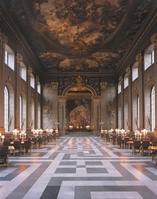300th anniversary for Greenwich Painted Hall
 The Old Royal Naval College in Maritime Greenwich, south east London is marking the 300th anniversary since Sir James Thornhill started painting its magnificent Painted Hall in 1708. It took over 19 years to complete and has been described as England’s answer to Rome’s Sistine Chapel and the finest painted architectural interior by an English artist.
The Old Royal Naval College in Maritime Greenwich, south east London is marking the 300th anniversary since Sir James Thornhill started painting its magnificent Painted Hall in 1708. It took over 19 years to complete and has been described as England’s answer to Rome’s Sistine Chapel and the finest painted architectural interior by an English artist.Designed by Sir Christopher Wren and built between 1696 and 1751, the Old Royal Naval College started life as the Royal Hospital for Seamen providing a home for retired and injured sailors.
It became the Royal Naval College in 1873, a role which lasted for 125 years until 1998; this year also marks the tenth anniversary since it was vacated by the MoD and the fine buildings became home to the University of Greenwich and Trinity College of Music. Maritime Greenwich was designated a World Heritage Site in 1997 for its architectural, scientific, maritime and royal associations.
Artist Paid by the Square Yard
Sir James Thornhill, was commissioned by Greenwich Hospital to decorate this magnificent space in 1708, completing it in phases up to 1727. For his ‘great and laborious undertaking’ the artist was paid by the square yard at the rate of £3 for the ceilings and £1 for the walls amounting to a total of £6,685, 2 shillings 4 pence. He was also eventually knighted. With payment often in arrears, it is believed the strange hand gesture in his personal portrait on the West Wall may be a request for money.
Pensioners could not eat in the Hall while he was working and it was both too grand and too much of a tourist attraction when finished. Respectable visitors were admitted for 3d (1.25p) each and offered an explanatory leaflet in English and French, written by the artist. From about 1715 the income funded the education for ‘poor boys’ in what became the Greenwich Hospital School.
The allegorical theme of the huge and exuberant Lower Hall ceiling is the triumph of Peace and Liberty over Tyranny, and pays due tribute to William and Mary and British maritime power. In the Upper Hall Queen Anne surveys the continents of the world, America reputedly represented by an image of Pocahontas, while on the West Wall her Hanoverian successors, George I and his family, are shown in sober glory. Elsewhere much use is made of trompe l’oeil painting, on the columns, windowsills and in the vestibule.
In 1824 the Hall became the ‘National Gallery of Naval Art’ – or Naval Gallery for short – and remained so until the 1930s when its contents were transferred to the newly created National Maritime Museum. From the start of WWII, until the departure of the Royal Navy in 1998, the Hall was at last regularly used as a dining room. Today tourists share it during the day while on evening occasions guests can eat in the ‘finest dining hall in Europe’.
The actual date that Thornhill started painting, 29 June, will be marked by a Children’s Art Day when youngsters are invited to join a drop-in workshop between noon and 3pm to create their very own ‘piece of the Painted Hall’. A £1 donation per child is requested and the event is recommended for children aged 5 to 11 years.
250th Anniversary of Lord Nelson’s Birth
This year also marks the 250th anniversary since the birth of Admiral Lord Nelson on 29 September 1758; after being fatally wounded in battle he was laid in state in the Painted Hall and the naval uniform he wore on the fatal day, complete with bullet hole and blood stain, is on display in the Nelson Gallery at the nearby National Maritime Museum.
The Old Royal Naval College has a visitor centre including shop and café, near to Greenwich Pier, attached to which is Greenwich Tourist Information Centre. Both the Painted Hall and neo-classical Chapel of St Peter and St Paul offer free public entry; daily guided tours are also available which include the Victorian Skittle Alley and Jacobean Undercroft.
Other key attractions within the Maritime Greenwich World Heritage Site include the Queen’s House, Royal Observatory and Peter Harrison Planetarium, which are all part of the National Maritime Museum; the Fan Museum, Wernher Collection at the Ranger’s House, St Alfege Church, Greenwich Theatre, Greenwich Market and the Royal Park.
Travelling to Maritime Greenwich in 2008
Maritime Greenwich is easily reached by mainline train from London Bridge to Greenwich or via the Docklands Light Railway alighting at Cutty Sark. Alternatively there are several bus services coming through Greenwich or visitors can arrive by passenger boat at Greenwich Pier.
Docklands Light Railway (DLR) is currently carrying out improvements to the line which will allow great capacity on the trains. There will be some closures over the next few months affecting the journey to Cutty Sark station for Maritime Greenwich. In addition both Cutty Sark and Greenwich DLR stations will be closed over four weekends during July and August.
South Eastern Trains provide alternative overground services into Greenwich station from London Bridge, or visitors can take a river cruise from a choice of piers and disembark at Greenwich.
Passengers are advised to check before travelling online at Dlr.co.uk where the journey planner might also be of assistance.
Greenwich Pier is also under redevelopment with a new landing stage, restaurants and café which will create a stylish, new waterside environment scheduled to open summer 2009. The Pier remains open throughout its redevelopment period.
For further information on travel, events, places to visit and accommodation suggestions visit Greenwichwhs.org.uk.

